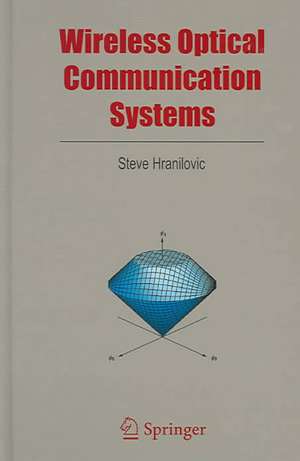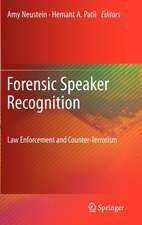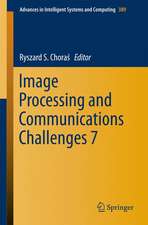Wireless Optical Communication Systems
Autor Steve Hranilovicen Limba Engleză Hardback – 2 sep 2004
| Toate formatele și edițiile | Preț | Express |
|---|---|---|
| Paperback (1) | 636.30 lei 6-8 săpt. | |
| Springer – 18 oct 2010 | 636.30 lei 6-8 săpt. | |
| Hardback (1) | 641.71 lei 6-8 săpt. | |
| Springer – 2 sep 2004 | 641.71 lei 6-8 săpt. |
Preț: 641.71 lei
Preț vechi: 754.95 lei
-15% Nou
Puncte Express: 963
Preț estimativ în valută:
122.79€ • 128.55$ • 101.60£
122.79€ • 128.55$ • 101.60£
Carte tipărită la comandă
Livrare economică 05-19 aprilie
Preluare comenzi: 021 569.72.76
Specificații
ISBN-13: 9780387227849
ISBN-10: 0387227849
Pagini: 197
Ilustrații: XII, 197 p.
Dimensiuni: 155 x 235 x 18 mm
Greutate: 0.45 kg
Ediția:2005
Editura: Springer
Colecția Springer
Locul publicării:New York, NY, United States
ISBN-10: 0387227849
Pagini: 197
Ilustrații: XII, 197 p.
Dimensiuni: 155 x 235 x 18 mm
Greutate: 0.45 kg
Ediția:2005
Editura: Springer
Colecția Springer
Locul publicării:New York, NY, United States
Public țintă
Professional/practitionerCuprins
Wireless Optical Intensity Channels.- An Introduction to Optical Intensity Signalling.- Signalling Design.- Optical Intensity Signal Space Model.- Lattice Codes.- Channel Capacity.- Multi-Element Techniques.- The Multiple-Input/Multiple-Output Wireless Optical Channel.- Prototype Mimo Optical Channel: Modelling and Spatio-Temporal Coding.- Conclusions and Future Directions.
Textul de pe ultima copertă
Wireless Optical Communication Systems addresses the problem of designing efficient signaling and provides a link between the areas of communication theory and modem design for amplitude constrained linear optical intensity channel. Topics include historical perspective, channel impairments, amplitude constraints and the characteristics of popular optoelectronic components. A variety of wireless optical channel topologies are presented along with a survey and analysis of present day signalling techniques employed for these channels. The author provides a unifying framework for signalling design which allows the channel constraints to be represented geometrically and permits the use of modem design principles from electrical channels. Modulation schemes are designed using the formalism of lattice codes and a design process for signalling sets is specified.
The use of multiple-input/multiple-output (MIMO) wireless optical channels to improve the spectral efficiency of links is explored. The basic spatio-temporal modem design problem is specified and a spatial multiplexing gain is quantified. New spatial discrete multitone modulation is proposed and the unique features are discussed. Based on measurements on an experimental prototype, a channel model is formulated and a realizable spatio-temporal coding scheme is simulated to quantify performance gains.
This volume is organized for professional and academic readers engaged in modem design for wireless optical intensity channels. Significant background material is presented on both the properties as well as on fundamental communications principles. Wireless Optical Communication Systems can be used by physicists and experimentalists as an introduction to signalling design as well as communication systems designers.
The use of multiple-input/multiple-output (MIMO) wireless optical channels to improve the spectral efficiency of links is explored. The basic spatio-temporal modem design problem is specified and a spatial multiplexing gain is quantified. New spatial discrete multitone modulation is proposed and the unique features are discussed. Based on measurements on an experimental prototype, a channel model is formulated and a realizable spatio-temporal coding scheme is simulated to quantify performance gains.
This volume is organized for professional and academic readers engaged in modem design for wireless optical intensity channels. Significant background material is presented on both the properties as well as on fundamental communications principles. Wireless Optical Communication Systems can be used by physicists and experimentalists as an introduction to signalling design as well as communication systems designers.
Caracteristici
Provides practical guidelines for the design of signalling sets for wireless optical intensity channels and proposes new multiple-input/multiple-output (MIMO)signalling strategies which exploit spatial dimensions to improve data rates



















